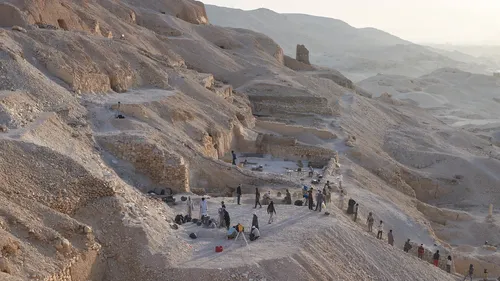
LHTT focuses on a cluster of tombs in the Theban Necropolis (Egypt). It investigates the evolution of the hillside and explores the history of the tombs from early 2nd mill. BCE to 20th c. CE.
Full Project Description
The University of Basel, Switzerland, has been conducting an overarching archaeological project on “Life Histories of Theban Tombs” (LHTT) at the ancient hillside cemetery of Sheikh ‘Abd el-Qurna (SAQ) in Western Thebes since November 2015. In cooperation with partners at the ETH and the University of Zurich and an international expert team, LHTT investigates two clusters of mostly unfinished rock-cut tombs from the beginning of the Middle Kingdom (1900–1750 BCE) and the mid-Eighteenth Dynasty (c. 1450‒1400 BCE). The latter group of tombs can be understood as part of a planned cemetery opened for a small elite with close personal links to Pharaohs Thutmose III and Amenhotep II.
These tombs share a long use history. Distinction can be made between their “systemic” use, including their creation, decoration, use and reuse as sacred spaces for burials and cultic performance during Antiquity (not excluding phases of severe looting and damage), and “non-systemic” use in more recent times, notably as dwelling space for Coptic monks from the 6th to the 8th centuries CE, as well as modern villagers during the 19th and 20th centuries.
The project promotes the interaction between Egyptology, archaeology, art history, philology, physical anthropology, natural and computer sciences, geomatics, and several archaeometrical fields. It also aims at analysing the emergence and life cycles of the investigated tombs in their natural and built environment. Research focuses on landscape development, including recent activities in the cemetery and in individual tombs, tomb construction and decoration practices, reception, and funerary and domestic (re)uses of the tombs over time.
The archaeological site stretches over the western and central parts of the SAQ hill; it includes an area covered by a huge cone of debris (AU1000) and comprises two clusters of rock cut tombs: TT95A‒C and K85 in the west, and TT84-K453-K90-K555 in the centre of the hillside. Tomb K555 was, until recently, buried beneath debris accumulations of AU1000. It is currently being excavated (courtyard and inner halls). To the east of TT84 lie the remains of a construction site (AU6000), which were also re-excavated.
The publication plan is divided in two axes. On the one hand, groups of relevant finds from the first cluster of tombs (TT95A–C and K85) are the subject of various separate articles, some of which are already published in a single volume (see Gnirs (ed.) 2021). On the other hand, the complete study of the decorative programmes of TT84 and K555 (texts and iconography), including archaeological finds from the recent excavations of K555 and area AU1000, is ongoing.
تقوم جامعة بازل السويسرية منذ نوفمبر 2015 بتنفيذ مشروع أثري شامل بعنوان "قصص الحياة في مقابر طيبة" في الجبانة القديمة بتل الشيخ عبد القرنة في طيبة الغربية. من خلال التعاون مع شركاء من المعهد السويسري الفيدرالي للتكنولوجيا وجامعة زيورخ ومع فريق من الخبراء الدوليين يقوم المشروع ببحث ودراسة مجموعتين من المقابر المنقورة في الصخر غير المكتملة التي يعود تاريخها إلى بداية عصر الدولة الوسطى (1900-1750 قبل الميلاد) ومنتصف الأسرة الثامنة عشرة (حوالي 1450-1400 قبل الميلاد). يمكن فهم المجموعة الأحدث من هذه المقابر بوصفها جزءًا من جبانة خُصصت لنخبة محدودة كانت تتمتع بعلاقات شخصية مع الملكين تحتمس الثالث وأمنحتب الثاني. تتشارك هذه المقابر تاريخًا طويلًا من الاستخدام. ويمكن التمييز بين استخدامها "التقليدي"، بما في ذلك إنشاؤها وزخرفتها واستخدامها وإعادة استخدامها باعتبارها أماكن مقدسة لدفن الموتى ولممارسة الشعائر الدينية في العصور القديمة (لا يُستنثى من ذلك مراحل النهب والتخريب الشديدين)، وبين استخدامها "غير التقليدي" في الآونة الأخيرة، لا سيما استخدامها محلًا لإقامة الرهبان الأقباط من القرن السادس إلى القرن الثامن الميلاديين ولسكن القرويين المحليين في العصر الحديث خلال القرنين التاسع عشر والعشرين. يعزز المشروع التفاعل والتعاون بين علم المصريات وعلم الآثار وتاريخ الفن وفقه اللغة والأنثروبولوجيا الفيزيائية وعلوم الطبيعة وعلوم الحاسوب والهندسة الجيولوجية والعديد من العلوم الأثرية. كما يهدف المشروع إلى دراسة نشأة المقابر محل البحث ودورات الحياة بها في بيئتها الطبيعية وتلك التي هي من صنع الإنسان. تركز الأبحاث على تطور الجغرافيا الأثرية للموقع، بما في ذلك الأنشطة الحديثة في الجبانة وفي المقابر الفردية وممارسات بناء المقابر وزخرفتها واستقبال الموتى والاستخدامات أو إعادة الاستخدامات الجنائزية والسكنية للمقابر على مر العصور. يمتد الموقع الأثري للمشروع في القسمين الغربي والأوسطي من تل الشيخ عبد القرنة، ويشمل منطقة تغطيها كومة ضخمة من الرديم (الوحدة الأثرية 1000AU). يضم الموقع مجموعتين من المقابر المنقورة في الصخر: TT95A-C و K85 في القسم الغربي من التل، و TT84-K453-K90-K555 في القسم الأوسطي منه. كانت المقبرة K555 حتى وقت قريب مدفونة تحت الرديم المتراكم القادم من الوحدة الأثرية AU1000. تخضع هذه المقبرة في الوقت الراهن إلى أعمال التنقيب (فناء المقبرة وقاعاتها الداخلية). وتقع إلى الشرق من المقبرة TT84 بقايا موقع بناء (الوحدة الأثرية AU6000) حيث أعاد المشروع إجراء أعمال التنقيب فيها أيضًا. تنقسم خطة النشر العلمي لهذه المقابر ومحتوياتها إلى محورين. يشمل المحور الأول نشر مجموعات من الآثار المكتشفة ذات الصلة القادمة من المجموعة الأولى من المقابر (TT95A-C، K85) في العديد من المقالات الفردية، بعضها منشور بالفعل في مجلد واحد (انظر: Gnirs (ed.) 2021). ويشمل المحور الثاني نشر الدراسة المتكاملة الجارية لممارسات وبرامج زخرفة المقبرتين TT84 و K555 (النصوص والمناظر)، بما في ذلك الآثار التي أسفرت عنها أعمال التنقيب الأخيرة في المقبرة K555 وفي منطقة الوحدة الأثرية AU1000.